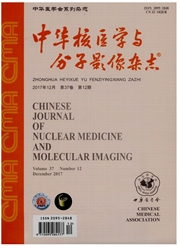

 中文摘要:
中文摘要:
目的通过研究^99Tc^m-精氨酸-谷氨酸-苏氨酸(RET)在荷人肺癌H1299裸鼠体内的分布及显像,探讨其用于肺癌显像的可行性。方法采用^99Tc^m-直接法标记RET,再行^99Tc^m-RET与NSCLC细胞H1299的结合实验。荷人肺癌H1299裸鼠尾静脉注射^99Tc^m-RET后,行不同时间(15、30min,1、2.4、8、24、48h组各4只鼠)体内分布实验,分别测定组织放射性摄取(%ID/g);另取荷瘤鼠3只,注射4.81MBq^99Tc^m-RET后于0.5、1、2、4.5、5、6h行γ显像。结果^99Tc^m-直接标记RET的标记率为(93.15±2.02)%,与H1299细胞的最高结合率为(3.56±0.37)%。荷瘤裸鼠尾静脉注射^99Tc^m-RET后4h肿瘤放射性摄取达(4.96±1.05)%ID/g,肝脏、脾脏有较多放射性摄取[(15.89±1.84)%ID/g和(10.83±1.66)%ID/g];而心脏和血液的放射性摄取较少,相应的T/NT分别为5.70±0.21和12.40±0.11。注射^99Tc^m-RET后4.5~6.0h肿瘤显影清晰。结论^99Tc^m-RET具有亲肺癌的特性,有可能成为一种亲肺癌显像剂。
 英文摘要:
英文摘要:
Objective To investigate the biodistribution and gamma imaging of ^99Tc^m-arginine-glutamate-threonine (RET) in nude mice bearing lung cancer xenografts and to explore its feasibility for human lung cancer imaging. Methods RET was labeled directly with ^99Tc^m. The binding efficiency of ^99Tc^m-RET with human NSCLC H1299 cells was measured. ^99Tc^m-RET was injected via the tail vein in nude mice bearing H1299 xenografts. The mice(n=32) were sacrificed at different time points: 15 min, 30 min, 1 h, 2 h, 4 h, 8 h, 24 h, and 48 h. Organs of interest were excised, weighted and counted by a gamma counter. The organ uptake was calculated as %ID/g. The gamma imaging was performed on 3 mice at 0.5, 1, 2, 4, 4.5, 5, 6 h after intravenous injection of 4.81 MBq ^99Tc^m-RET. Results The radiolabeling yield of ^99Tc^m-RET was (93.15±2.02)%, and the binding efficiency of ^99Tc^m-RET with H1299 cells was (3.56±0.37)%. At 4 h after injection, the uptake of tumor, liver and spleen was (4.96±.05) %ID/g, (15.89±1.84) %ID/g and ( 10. 83±1.66) %ID/g and the T/NT was 5.70±0.21 for the heart and 12.40±0.11 for the blood. The tumor in nude mice could be best visualized at 4.5-6.0 h. Conclusion ^99Tc^m-RET might have potential to serve as a lung cancer imaging agent.
 同期刊论文项目
同期刊论文项目
 同项目期刊论文
同项目期刊论文
 期刊信息
期刊信息
